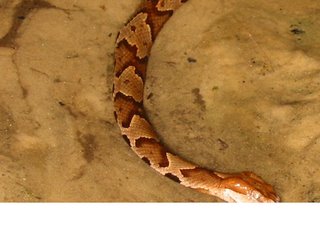 As my friend Tom back in Texas says "every snake seen on land is identified as a Copperhead or a Rattlesnake, and every snake seen in or near the water is identified as a Water Moccasin". He isn't far off the truth. So far in Fairfield Glade, anyone that I have talked to that has seen a snake says that it was a Copperhead. Yes, there are Copperheads here, but there are also many non-poisonous snakes.
As my friend Tom back in Texas says "every snake seen on land is identified as a Copperhead or a Rattlesnake, and every snake seen in or near the water is identified as a Water Moccasin". He isn't far off the truth. So far in Fairfield Glade, anyone that I have talked to that has seen a snake says that it was a Copperhead. Yes, there are Copperheads here, but there are also many non-poisonous snakes.For example, the beautiful snake in the first picture is a young Eastern Milksnake. Obviously the picture is not the whole snake, it is only the undamaged portion. Unfortunately it was run over on the road a couple of hundred yards from our house. Milksnakes are non-poisonous and beneficial. But I would bet that fewer than one in one hundred people who saw this snake on the road knew what it was. I'll bet most people would have called this a Copperhead.
Two days after this picture was taken there was a dead Blacksnake on the same road within a hundred yards of the corn snake. It was about 4 1/2 feet long. I didn't have my camera and when I returned, it was gone. Probably the crows got it.
Last Friday while playing golf, I stepped onto a rock in a stream and another non-poisonous snake, a water snake, caused me a little adrenalin spike as it slipped into the water from the same rock that I was on. The snake probably had a little adrenalin spike also.
There are Timber Rattlesnakes in our area, although someone I know at the Tennessee Wildlife Resources Agency says they are very rarely seen. But there are some around because the workers killed one a few houses away from my house last fall. Rattlesnakes are kind of hard to misidentify because of the rattles on their tail.
 Now, this snake is a real Copperhead. Again, unfortunately, this one was also dead. We found this snake on a Hiking Club trip along the trail. Someone hiking on the trail before us probably saw the snake and killed it. Copperheads are poisonous but they have less potent venom, shorter fangs, and smaller doses of poison than rattlesnakes. Copperhead bites are usually not even treated with anti-venom, although that shouldn't encourage you to pick one up because their bite will be very painful if venon is injected (it isn't always).
Now, this snake is a real Copperhead. Again, unfortunately, this one was also dead. We found this snake on a Hiking Club trip along the trail. Someone hiking on the trail before us probably saw the snake and killed it. Copperheads are poisonous but they have less potent venom, shorter fangs, and smaller doses of poison than rattlesnakes. Copperhead bites are usually not even treated with anti-venom, although that shouldn't encourage you to pick one up because their bite will be very painful if venon is injected (it isn't always).So before you kill that Copperhead that you see, remember that it might not even be a Copperhead. Also, even if it is, just leave it alone to control the rodents and frogs and such. Plus, it is illegal to kill a snake....probably a law that isn't often enforced, but it is illegal.
By the way, I read somewhere that most snake bites involve two variables.....teen or older males.... and alcohol. Imagine that!



